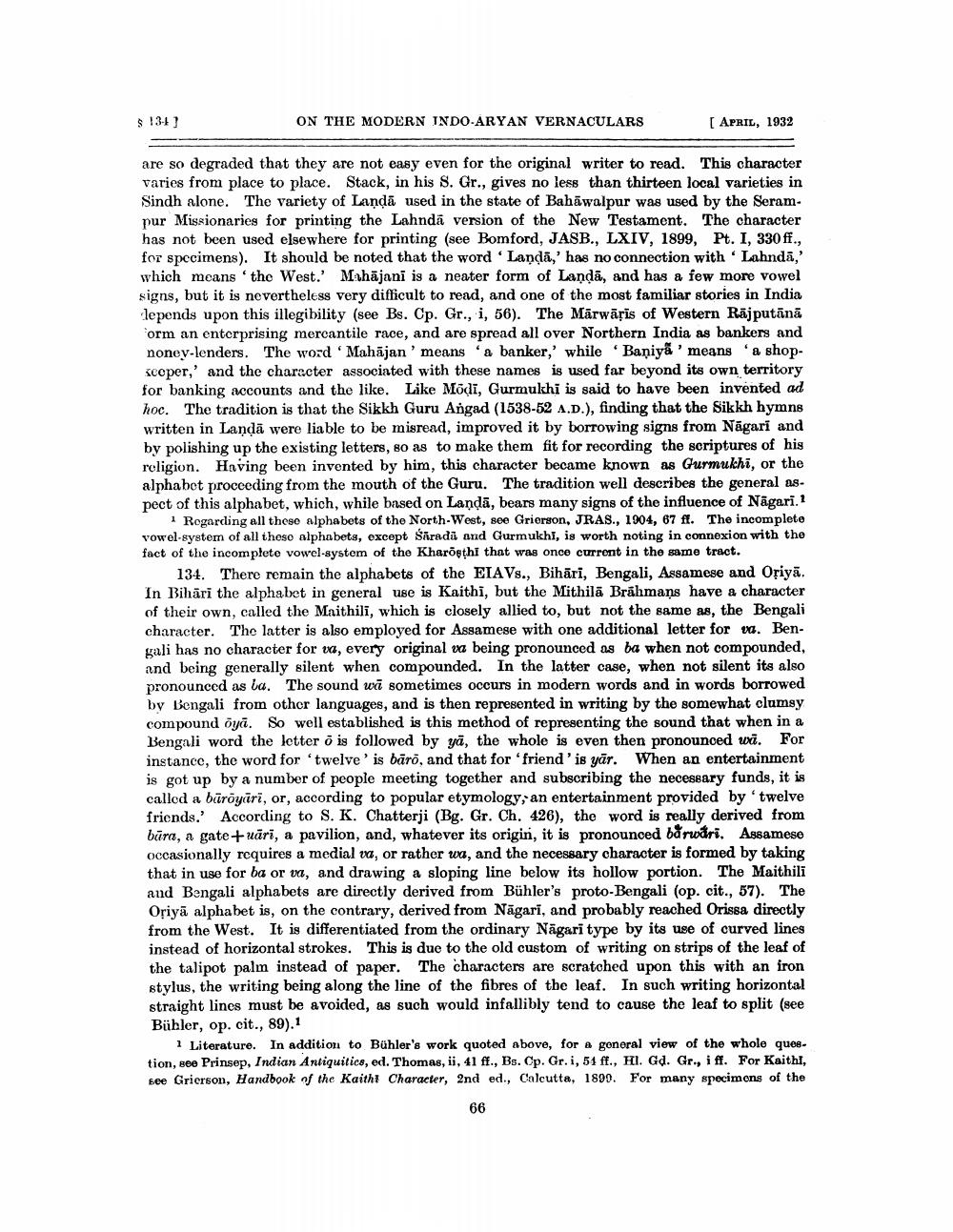________________
$ 13-4)
ON THE MODERN INDO-ARYAN VERNACULARS
[ APRIL, 1932
are so degraded that they are not easy even for the original writer to read. This character varies from place to place. Stack, in his S. Gr., gives no less than thirteen local varieties in Sindh alone. The variety of Landă used in the state of Bahāwalpur was used by the Serampur Missionaries for printing the Lahndā version of the New Testament. The character has not been used elsewhere for printing (see Bomford, JASB., LXIV, 1899, Pt. I, 330 ff., for specimens). It should be noted that the word 'Landā,' has no connection with 'Lahndā,' which means the West.' Mahājani is a neater form of Landā, and has a few more vowel signs, but it is nevertheless very difficult to read, and one of the most familiar stories in India lepends upon this illegibility (see Bs. Cp. Gr., i, 56). The Mārwäris of Western Rājputāna form an enterprising mercantile race, and are spread all over Northern India as bankers and noney-lenders. The word 'Mahājan' means a banker,' while Baniya 'means 'a shopscoper,' and the character associated with these names is used far beyond its own territory for banking accounts and the like. Like Mödi, Gurmukhi is said to have been invented ad hoc. The tradition is that the Sikkh Guru Angad (1538-52 A.D.), finding that the Sikkh hymns written in Landā were liable to be misread, improved it by borrowing signs from Nāgari and by polishing up the existing letters, so as to make them fit for recording the scriptures of his religion. Having been invented by him, this character became known as Gurmukhi, or the alphabot proceeding from the mouth of the Guru. The tradition well describes the general as. pect of this alphabet, which, while based on Landā, bears many signs of the influence of Nāgari.?
1 Rogarding all theso alphabets of the North-West, see Grierson, JRAS., 1904, 67 ff. The incomplete vowel system of all thoso alphabets, except Saradů and Gurmukhi, is worth noting in connexion with the fact of the incomplete vowel-system of the Kharõethi that was once current in the same tract.
134. There remain the alphabets of the EIAVs., Bihāri, Bengali, Assamese and Oriyā. In Bihāri the alphabet in general use is Kaithi, but the Mithilā Brāhmans have a character of their own, called the Maithili, which is closely allied to, but not the same as, the Bengali character. The latter is also employed for Assamese with one additional letter for vs. Bengali has no character for va, every original va being pronounced as ba when not compounded, and being generally silent when compounded. In the latter case, when not silent its also pronounced as la. The sound w sometimes occurs in modern words and in words borrowed by Bengali from other languages, and is then represented in writing by the somewhat clumsy compound öyā. So well established is this method of representing the sound that when in a Bengali word the letter o is followed by yā, the whole is even then pronounced wa. For instance, the word for 'twelve' is bāro, and that for 'friend' is yār. When an entertainment is got up by a number of people meeting together and subscribing the necessary funds, it is called a büröyāri, or, according to popular etymology, an entertainment provided by 'twelve friends. According to S. K. Chatterji (Bg. Gr. Ch. 426), the word is really derived from būra, a gate+uāri, a pavilion, and, whatever its origin, it is pronounced barwari, Assamese occasionally requires a medial va, or rather wa, and the necessary character is formed by taking that in use for ba or va, and drawing a sloping line below its hollow portion. The Maithili and Bengali alphabets are directly derived from Bühler's proto-Bengali (op. cit., 57). The Oriyā alphabet is, on the contrary, derived from Nāgari, and probably reached Orissa directly from the West. It is differentiated from the ordinary Nāgari type by its use of curved lines instead of horizontal strokes. This is due to the old custom of writing on strips of the leaf of the talipot palm instead of paper. The characters are scratched upon this with an iron stylus, the writing being along the line of the fibres of the leaf. In such writing horizontal straight lines must be avoided, as such would infallibly tend to cause the leaf to split (see Bühler, op. cit., 89). 1
1 Literature. In addition to Bühler's work quoted above, for a gonoral view of the whole question, see Prinsep, Indian Antiquitics, ed. Thomas, ii, 41 ff., Bs. Cp. Gr. i, 51 ff., Hl. Gd. Gr., i ff. For Kaithi, see Grierson, Handbook of the Kaitht Character, 2nd ed., Calcutta, 1890. For many specimens of the
66




